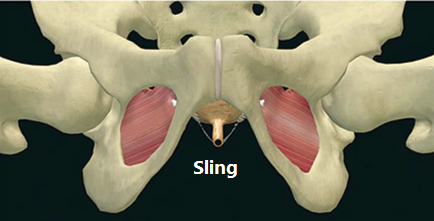Sling Procedures are not a new phenomenon; after all, the original Sling Procedure was performed in 1907 by Von Giordano utilizing a gracilis muscle graft around the urethra. Since then, a number of improvements have been made to the Sling Procedure, particularly in the past 15 years. Sling Procedures over the last decade will be summarized here.
What is a Sling Procedure?

A Sling Procedure is performed to manage1 urinary incontinence2 primarily in women. Stress urinary incontinence is believed to affect 15 – 60% of women, although this problem often goes unreported. While incontinence is not well-understood, a common way to treat this problem is through the use of a pubovaginal sling. Here, a band of material is placed below the bladder neck or mid-urethra to prevent descent during times of physical activity, coughing, sneezing, or other instances where incontinence may occur.
How Have Sling Procedures Changed Over the Last Decade?
Pubovaginal Sling
Historically, surgeons have relied on the pubovaginal sling for the treatment of urinary stress incontinence. Here, a material (i.e. synthetic mesh, biomaterial, or a graft of the patient’s own tissue) is attached beneath the mid- or proximal urethra and is sutured at each end onto a solid anatomical structure, such as the rectus sheath, pelvic side walls, or pubic bone.
This sling supports the urethra as it undergoes pressure changes from the abdomen. The internal sphincter muscles are also supported to help keep the urethral opening closed. This procedure has a high success rate.
However, this method has come under intense scrutiny lately, particularly when synthetic mesh is used, as patients have reported long-term adverse side effects. Synthetic material rejection, difficulty urinating, and bladder and urethra injury, among others, have been experienced. In addition, the pubovaginal sling procedure is mildly invasive with a long recovery time.
Tension-free Vaginal Tape Sling
To reduce the side effects associated with a pubovaginal sling, particularly due to the invasive nature of that surgery, the Tension-free Vaginal Tape Sling (TVT) was developed. This procedure is a mid-urethral sling composed of polypropylene mesh. The surgery is a retropubic procedure, performed between the pubic bone and bladder. The sling is attached to a needle and passed through the retropubic area. Because this surgery is “blind,” the surgeon will not be able to see the sling after it is inserted with a needle and there is a high risk of bladder and urethral injury.
While this surgery has been shown to be safe for the treatment of stress urinary incontinence, there are still risks involved. The synthetic material can erode, organ perforation can occur, and infection may develop if mesh fragments cause abrasions on nearby organs.
Transobtrurator Midurethral Synthetic Sling
To eliminate many of the side effects of the TVT sling, a second type of mid-urethral sling procedure has been developed. The transobturator tape sling (TOT) is similar to TVT, but the sling is passed through the labia as opposed to the retropubic area. The sling is then threaded beneath the urethra. This technique has a reduced risk of bladder and urethral injury.
While the chances of side effects with this procedure are reduced versus other methods, mesh erosion, difficulty urinating, and organ injury can still occur.
Mini Slings
The newest type of sling is the Mini-Sling. These are also comprised of synthetic material, and are even less invasive. A single vaginal incision is made and the mesh is placed in a u-shaped position around the mid-urethral area. Like the other slings mentioned here, the mesh is held in place by scar tissue. Although mini-slings result in fewer bladder and urethral injuries than TVT and TOT procedures, research has shown they may not be as effective in treating incontinence as other methods, particularly the TOT procedure.
Ultimately, the future for Sling Procedures1 is likely trending toward biomaterial, given the recent difficulty with synthetics. While TOT and TVT procedures have similar and very good success rates, the Mini Sling – despite fewer side effects – may not treat stress urinary incontinence as effectively.
If you liked the above article, you might also like our recent post on Urodynamics Catheters: http://info.bhnco.com/blog/air-charged-and-water-charged-urodynamic-catheters-a-comparison
References
- Lobel, B., Manunta, A., & Rodriguez, A. (2001). The management of female stress urinary incontinence using the sling procedure. BJU International, 88(8), 832-839. doi:10.1046/j.1464-4096.2001.02443.x Link
- Kuo, H. (2002). The surgical results of the pubovaginal sling procedure using polypropylene mesh for stress urinary incontinence. BJU International, 88(9), 884-888. doi:10.1046/j.1464-4096.2001.01324.x Link
- Barboglio, P. G., & Gormley, E. A. (2013). The fate of synthetic mid-urethral slings in 2013: A turning point. Arab Journal of Urology, 11(2), 117-126. doi:10.1016/j.aju.2013.04.005 Link


